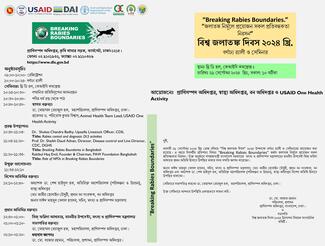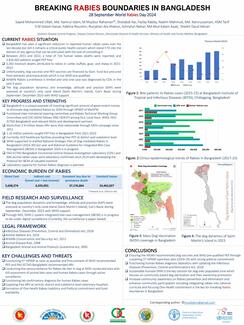
BREAKING RABIES BOUNDARIES IN BANGALDESH
Bangladesh is a unique example of investing a significant amount of government money to eliminate dog-mediated Rabies. The National Rabies Elimination Program (NREP) journey started with the Ministry of Health and Family Welfare (MoHFW) in 2010. Next year, MDV was piloted in Cox's Bazar district with technical support from the World Health Organization (WHO) and World Animal Protection; formerly known as WSPA. During that time for tackling inhumane dog killing practice, the Local Government and Rural Development (LGRD) financed MoHFW for district-wise municipality-level MDV, with an interministerial collaboration with the Ministry of Fisheries and Livestock (MoFL).
In 2011, production of Nerve Tissue Vaccine (NTV) at Institute of Public Health (IPH) was restricted. The Tissue Culture Vaccine (TCV) distribution began in 2014. From then, with the snowball concept, the MDV was scaled-up across the country and finally it was included in the 3rd Health, Population and Nutrition Sector Program (HPNSP) and named as the Zoonotic Disease Control Program (ZDCP), Communicable Disease Control (CDC) operational plan of Directorate General of Health Services (DGHS) under MoHFW and successfully continued as the 4th HPNSP CDC operational plan (July 2019-June 2024) and unfortunately, the 5th HPNSP didn’t pass yet!
Before NREP initiative, 2100 (95% CI: 1575-2670) people died of Rabies with an annual bite case were 166,590 (95% CI: 163350-170 550). For rural settings, the human: dog ratio was 120 (95% CI: 55-184) and the dog density was 14 dog/km2 (95% CI 3.7-24). In rural areas, 65% of the dogs are free-roaming (not owned). However, there has been a significant reduction in reported human rabies deaths over the years, decreasing from 2000 deaths before 2010 to 1500 in 2012, and further decreasing to 200 deaths in 2015. Current study says, the total dog population is 1.9 million dogs (95% CI: 1.7-2.2 million dogs) and human-to-dog ratio is 85.83:1 (95% CI: 74.63 - 97.03) and dog-mediated reported Rabies human cases are under 50. Since 2011, over 2.9 million doses of Anti Rabies Vaccine (ARV) were shot nationwide through MDV drive and 1.33 million patients sought free PEP from 2021-2023 through 410 healthcare facilities at district and subdistrict levels. Between 2011 and 2022, a total of 724 human rabies deaths were reported, and 2,834,663 patients sought PEP with no charges which is representing an economic burden to public health.
Rabies also presents a considerable challenge for the valuable livestock industry in Bangladesh. 3,283 livestock deaths attributed to rabies in cattle, buffalo, goat, and sheep in 2021-2023. Studies from 2009 to 2018 identified dogs and jackals as the primary transmitters of rabies to livestock. Since 2019 the Central Disease Investigation Laboratory (CDIL) is providing state-of-the-art for rabies diagnosis with support from FAO-ECTAD. CDIL confirmed 606 animal rabies cases from 2021-2023 and contributed monetary compensation to the livestock owners. In 2021, FAO-ECTAD Bangladesh established the Rabies Acton Center for Excellence (RACE) which supported MoFL in developing the protocol for integrated bite case management (IBCM) of valuable livestock and conducted a dog population assessment in Dhaka in coordination with NREP in 2021.
WHO is supporting technical assistance to CDC-DGHS in developing the National Dog-mediated Rabies Strategic Plan (2024-30); updating the National Guideline for IBCM of Bangladesh in 2024; coordinating with the National Technical Working Group for Rabies and the interministerial (MoHFW, MoLF and LGRD) National Rabies Steering Committee. With an aim of piloting sustainable humane Dog Population Management (DPM), WHO supported NREP to conduct the dog population census and knowledge, attitude and practice (KAP) assessments (September-December 2023) on Saint Martin’s Island (country’s only coral island). In this study, Saint Martin’s Island is identified as the most dog overpopulated zone of Bangladesh where the dog population size is 1144 (1093-1194; 95% CI), the dog and human ratio is 1:9.51 with the dog density is 381 dog/ km2. Currently, in Bangladesh, ARV and PEP are financed by a government fund by MoHFW but procured through domestic pharmaceutical companies. PEPs are not WHO pre-qualified and ARVs are not FAO-ECTAD Bangladesh recommended.
The key challenges include functioning 5th HPNSP as soon as possible; procurement of WHO recommended PEP and FAO-ECTAD Bangladesh recommended ARV; conducting the serosurveillance for Rabies Ab titer in dog at MDV conducted area with GIS assessment of animal bite cases and human Rabies cases through active surveillance; functioning lab confirmatory diagnosis for human Rabies cases and supplying free ARV at central, district and subdistrict level veterinary hospitals.
In Bangladesh, Rabies is considered a typical example of a zoonotic infection that does not fit into the domain of a single agency that can be entrusted with the task of controlling it. For achieving the ZERO BY 30 THE GLOBAL STRATEGIC PLAN to end human deaths from dog-mediated Rabies by 2030 developed by WHO the main challenges need to tackled. Procurement of quality dog vaccines and human PEP is a must. Last but not the least, forming the national Rabies taskforce with political commitment and fund availability is mandatory in the BREAKING RABIES BOUNDARIES in Bangladesh.
M MUJIBUR RAHAMAN DVM, MS (Medicine)
Ministry of Health and Family Welfare, Bangladesh
Event images

